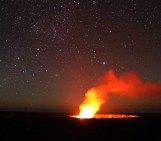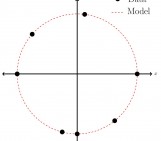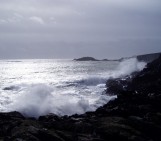Satellites are now so ubiquitous in our lives that there is something of a precedent to take them for granted. A normal daily routine for may people across the world may include watching television (satellite) as you check your twitter account (satellite) and have a look at the weather (satellite), all before you’ve even eaten your breakfast (not a satellite); whilst for those of us in the remote sensing community, whose work consists of analysing data from a large plethora of Earth-observing satellites, it can often seem that our lives are intertwined with those majestic flying machines as they dance their cosmic waltz far above the confines of planet Earth. It is almost staggering to believe that just over 50 years ago there was not a single manmade satellite in space, especially when you take into the consideration the fact that since its conception in 1957 the United States Satellite Surveillance Network (SNN) has chartered some 8,000+ anthropogenic obiters.
After the Second World War, the two global powerhouses of that era, the USA and the USSR, found themselves locked in a conflict of attrition that will come to be known as the Cold War. A war whose victors are judged not by the more conventional markers of land gain or battle tallies, but rather through the accumulation of weaponry and the rapid advancement of technology, of which the race to get into space plays a key and pivotal role. Most people, if asked who they considered to be the winners of the Space Race, would tell you that it was of course the USA, taking one small step for man and one giant leap for capitalism when Neil Alden Armstrong walked across the lunar landscape on July 21st 1969. Ask another group of people from a certain vintage or scientific persuasion, and they would probably tell you that the true winners of the Space Race were the Soviets, seeing as they were the first to actually get something up there with the launch of Sputnik 1 on October 4th 1957. But for me there can only be one winner, and it is neither Apollo 11 nor Sputnik 1, but instead the much less lauded US satellite: Explorer 1.
The Sputnik satellite may have been the first into space, and the Apollo missions may have bee the first to demonstrate the capability of manned spaceflight, but as an Earth observational scientist it was the Explorer 1 satellite that I find to be the most intriguing, being as it was the first to carry a scientific payload; a set of instrumentation which would be used to make the first great scientific discovery from space.
The achievements of the Russian polymaths in ensuring that the Soviets were the first into space should of course never be overlooked, nor would it be strictly fair to say that the scientific significance of Sputnik 1 disappeared as soon as it had successfully reached the edge of the atmosphere – by measuring the drag on the satellite, scientists were able gain useful information about the density of the upper atmosphere – but I like to think of Sputnik 1 as that valiant guest at a wedding, who wishing to get the party started with suitable aplomb, makes a line straight for the empty dance floor only to find that once there they lack any of the necessary moves to do anything of particular note. Explorer 1 on the other hand can be thought of as the louder, more eccentric cousin of Sputnik 1, strutting up to the dance floor without a tie (incredibly there was no tape recorder installed on Explorer 1, meaning that data could only be analysed in near real time as it was transmitted back down the scientists on the ground) before starting to cut shapes that would make even a computerised lathe turn green with envy.

From left to right: William H. Pickering, director of the Jet Propulsion Laboratory, which designed and built Explorer 1. James A. Van Allen, University of Iowa physicist who directed the design and creation of Explorer’s instruments.
Wernher von Braun, head of the U.S. Army Ballistic Missile Agency team that designed and built the Jupiter-C rocket (Source: Smithsonian National Air and Space Museum).
Explorer 1 was launched on the 31st January 1958, becoming the first of the USA’s forays into the vast unknowns of the surrounding cosmos. The design and build of the scientific payload was Lead by Dr. James Van Allen of the University of Iowa, its purpose being to measure cosmic rays as they made their way from the Supernovae explosions of distant stars within our galaxy and towards the Earth. The instrumentation was effectively a Geiger-Müller counter, set up to count the number of high energy cosmic rays as they passed through the relatively fragile shell of the satellite’s metallic exterior, and it was expected that the instrument would return values of approximately 30 rays per second. However, the scientists noted that at certain points in its orbit the instrumentation was returning values of 0 rays per second. Upon closer inspection of the data (along with the measurements taken by Explorer 3, launched on 26th March 1958, and complete with requisite tape recorder) it turned out that these zero values all seemed to be concentrated around South America, and that they only seemed to be present when the satellite was flying at an altitude of greater than 2000 km; at altitudes less than this the instrument recorded the expected 30 counts per second. The team at Iowa soon deduced that these zero counts weren’t zero counts at all, rather they were errors in the data brought about by the instrumentation being bombarded by a powerful stream of highly energised particles that were beyond its measuring capabilities. Van Allen (and others at the University of Iowa) proposed that the reason for this localised concentration was a doughnut-shaped belt of highly energized particles, trapped in formation as a result of the Earth’s magnetic field. These belts have since been named after their discoverer (and not as I had assumed, much to the amusement of one of my undergraduate lecturers, after US rock-hero Eddie van Halen), becoming the first scientific discovery to be made from space.
It was this monumental achievement that formed a significant contribution towards the potential of satellites to inform on the many wonders of our home planet, and it is for this reason that I put forward the Explorer 1 (and by association the USA – sorry soviet fans) team as the true winners of the Space Race, a worthy recipient of a truly intergalactic (well ok, monogalactic) battle.

Sam is a postdoctoral research assistant at the University of Manchester, where he spends most of his time working on the development of an algorithm for the retrieval of trace and greenhouse gas measurements from aircraft measured spectra, an algorithm that he affectionately refers to as MARS (the Manchester Airborne Retrieval Scheme). In his spare time Sam enjoys convincing scientists that they can learn to communicate their research more effectively by embracing theatrical technique in all its many guises.
Thanks for reading!





